Predictions & Data for this entry
| Model: abp | climate: A, C, D | migrate: | phylum: |
| COMPLETE = 3.5 | ecozone: TH, TPi | food: biCii | class: |
| MRE = 0.243 | habitat: 0iTh, 0iTf, 0iTi, 0iTs, 0iTg | gender: D | order: |
| SMSE = 0.134 | embryo: Th | reprod: O | family: |
Zero-variate data
| Data | Observed | Predicted | (RE) | Unit | Description | Reference |
|---|---|---|---|---|---|---|
| t01_25 | 1.72 | 1.976 | (0.149) | d | duration of instar 1 at 25 C | OmkaSriv2003 |
| t12_25 | 1.64 | 1.58 | (0.03654) | d | duration of instar 2 at 25 C | OmkaSriv2003 |
| t23_25 | 1.84 | 1.558 | (0.1533) | d | duration of instar 3 at 25 C | OmkaSriv2003 |
| t34_25 | 2.75 | 1.987 | (0.2774) | d | duration of instar 4 at 25 C | OmkaSriv2003 |
| Ww01 | 0.00226 | 0.0009596 | (0.5754) | g | wet weight of instar 1 | OmkaSriv2003 |
| Ww12 | 0.00555 | 0.003171 | (0.4286) | g | wet weight of instar 2 | OmkaSriv2003 |
| Ww23 | 0.01063 | 0.009731 | (0.0846) | g | wet weight of instar 3 | OmkaSriv2003 |
| Ww34 | 0.01979 | 0.03782 | (0.9112) | g | wet weight of instar 4 | OmkaSriv2003 |
| Wwj | 0.0424 | 0.06098 | (0.4383) | g | wet weight of fresh pupa | Baye2024 |
| Wwe_25 | 0.04063 | 0.04607 | (0.1338) | g | wet weight of female imago after emergence | OmkaSriv2003 |
| t01_23 | 3.1 | 2.479 | (0.2004) | d | duration of instar 1 at 23 C | ObryOrr1990 |
| t12_23 | 2.2 | 1.982 | (0.09921) | d | duration of instar 2 at 23 C | ObryOrr1990 |
| t23_23 | 2.4 | 1.954 | (0.1859) | d | duration of instar 3 at 23 C | ObryOrr1990 |
| t34_23 | 5.4 | 2.492 | (0.5384) | d | duration of instar 4 at 23 C | ObryOrr1990 |
| L1e | 0.765 | 0.7523 | (0.01662) | cm | body length of female imago after emergence | ObryOrr1990 |
| L2e | 0.591 | 0.5798 | (0.01897) | cm | body width female imago after emergence | ObryOrr1990 |
| Wwe_23 | 0.0377 | 0.04607 | (0.2219) | g | wet weight of female imago after emergence | ObryOrr1990 |
| t01_28 | 1.76 | 1.415 | (0.1961) | d | duration of instar 1 at 28 C | SingSing1993 |
| t12_28 | 1.8 | 1.131 | (0.3715) | d | duration of instar 2 at 28 C | SingSing1993 |
| t23_28 | 2.4 | 1.115 | (0.5353) | d | duration of instar 3 at 28 C | SingSing1993 |
| t34_28 | 3.15 | 1.423 | (0.5483) | d | duration of instar 4 at 28 C | SingSing1993 |
| tei_28 | 26.74 | 26.11 | (0.0237) | d | life span of female imago at 28 C | SingSing1993 |
| t01_24 | 2 | 2.212 | (0.1062) | d | duration of instar 1 at 24 C | FaroZhu2020 |
| t12_24 | 2 | 1.769 | (0.1156) | d | duration of instar 2 at 24 C | FaroZhu2020 |
| t23_24 | 2.47 | 1.744 | (0.2939) | d | duration of instar 3 at 24 C | FaroZhu2020 |
| t34_24 | 2.29 | 2.225 | (0.02851) | d | duration of instar 4 at 24 C | FaroZhu2020 |
| tei_24 | 48.16 | 40.82 | (0.1524) | d | life span of female imago at 24 C | FaroZhu2020 |
| pA1 | 2.502e+04 | 2.245e+04 | (0.1026) | J/d.g | dry-weight-specific assimilation rate at instar 1 | Sing1976 |
| pA2 | 2.983e+04 | 2.245e+04 | (0.2474) | J/d.g | dry-weight-specific assimilation rate at instar 2 | Sing1976 |
| pA3 | 3.72e+04 | 2.245e+04 | (0.3964) | J/g.d | dry-weight-specific assimilation rate at instar 3 | Sing1976 |
| pA4 | 3.732e+04 | 2.245e+04 | (0.3984) | J/g.d | dry-weight-specific assimilation rate at instar 4 | Sing1976 |
| pAe | 4.916e+04 | 712.5 | (0.9855) | J/g.d | dry-weight-specific assimilation rate of imago | Sing1976 |
| tbj_25 | 8.9 | 7.101 | (0.2021) | d | time since hatch at pupation at 25 C | KaluHode2004 |
| Wwe2_25 | 0.0388 | 0.04607 | (0.1873) | g | wet weight of female imago after emergence | KaluHode2004 |
| Ww0 | 0.000187 | 0.0003993 | (1.135) | g | initial wet weight of an egg | ChatNaz2020 |
| L1e_14 | 0.769 | 0.7523 | (0.02173) | cm | body length of female imago after emergence (14 d old) | Baye2024 |
| L2e_14 | 0.588 | 0.5798 | (0.01397) | cm | body width of female imago after emergence (14 d old) | Baye2024 |
| L1e_14a | 0.72 | 0.7523 | (0.04484) | cm | body length of female imago after emergence (14 d old) | Baye2024 |
| L2e_14a | 0.552 | 0.5798 | (0.05034) | cm | body width of female imago after emergence (14 d old) | Baye2024 |
| L1e_24 | 0.756 | 0.7523 | (0.004913) | cm | body length of female imago after emergence (24 d old) | Baye2024 |
| L2e_24 | 0.555 | 0.5798 | (0.04466) | cm | body width of female imago after emergence (24 d old) | Baye2024 |
| Wwe_14 | 0.0359 | 0.04607 | (0.2832) | g | wet weight of female imago after emergence (14 d old) | Baye2024 |
| Wwe_21 | 0.0659 | 0.04607 | (0.301) | g | wet weight of older female imago (21 d old) | Baye2024 |
| Wwj2 | 0.0415 | 0.06098 | (0.4695) | g | wet weight of fresh pupa | Baye2024 |
| Wwe_24 | 0.0658 | 0.04607 | (0.2999) | g | wet weight of older female imago (24 d old) | Baye2024 |
| Ww_asym | 0.08 | 191.7 | (2396) | g | asymptotic wet weight | guess |
Uni- and bivariate data
| Data | Figure | Independent variable | Dependent variable | (RE) | Reference |
|---|---|---|---|---|---|
| tWwB1 | 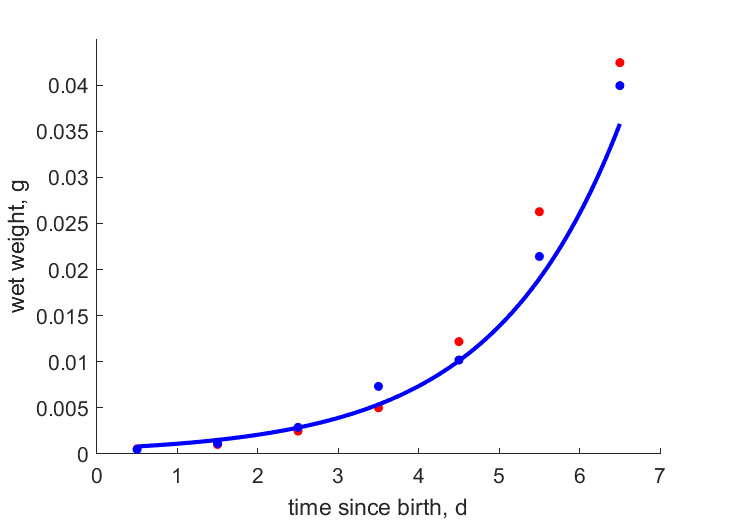 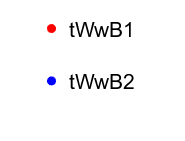 | time since birth | wet weight | (0.147) | Baye2024 |
| tWwB2 |   | time since birth | wet weight | (0.07921) | Baye2024 |
| tWwf1 |  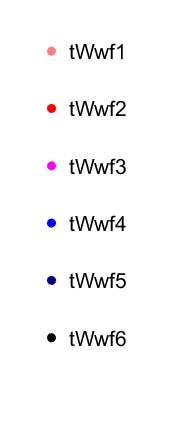 | time since birth | wet weight | (0.1651) | Blac1967 |
| tWwf2 |   | time since birth | wet weight | (0.1495) | Blac1967 |
| tWwf3 |   | time since birth | wet weight | (0.1129) | Blac1967 |
| tWwf4 |   | time since birth | wet weight | (0.1153) | Blac1967 |
| tWwf5 |   | time since birth | wet weight | (0.07788) | Blac1967 |
| tWwf6 |   | time since birth | wet weight | (0.1318) | Blac1967 |
| tL1 | 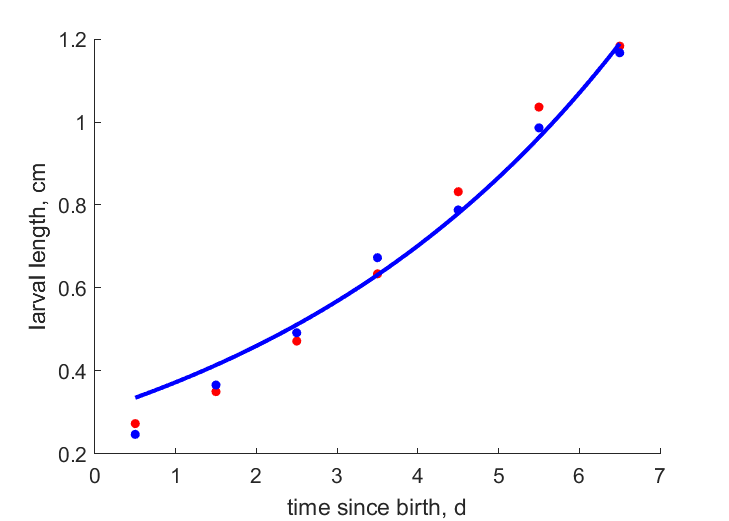 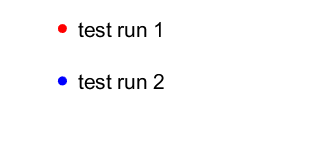 | time since birth | larval length | (0.05453) | Baye2024 |
| tL12 |   | time since birth | larval length | (0.0529) | Baye2024 |
| tL2 | 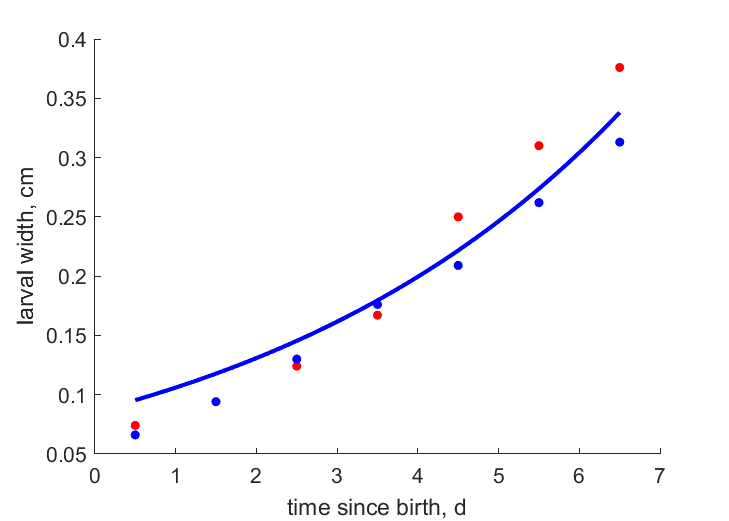 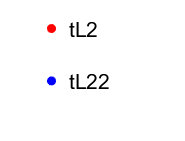 | time since birth | larval width | (0.08698) | Baye2024 |
| tL22 |   | time since birth | larval width | (0.09584) | Baye2024 |
| Tab | 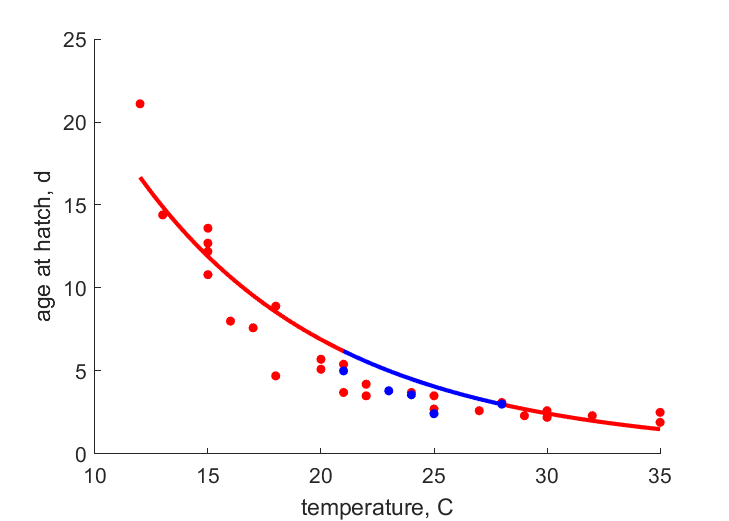  | temperature | age at hatch | (0.185) | TrilFrei1996 |
| Tab1 |   | temperature | age at hatch | (0.2489) | Sund1966, ObryOrr1990, FaroZhu2020, OmkaSriv2003, SingSing1993 |
| Ttje |   | temperature | time since pupation at emergence | (0.2421) | TrilFrei1996 |
| Ttje1 |   | temperature | time since pupation at emergence | (0.2967) | Sund1966, FaroZhu2020, OmkaSriv2003, SingSing1993 |
| TRi | 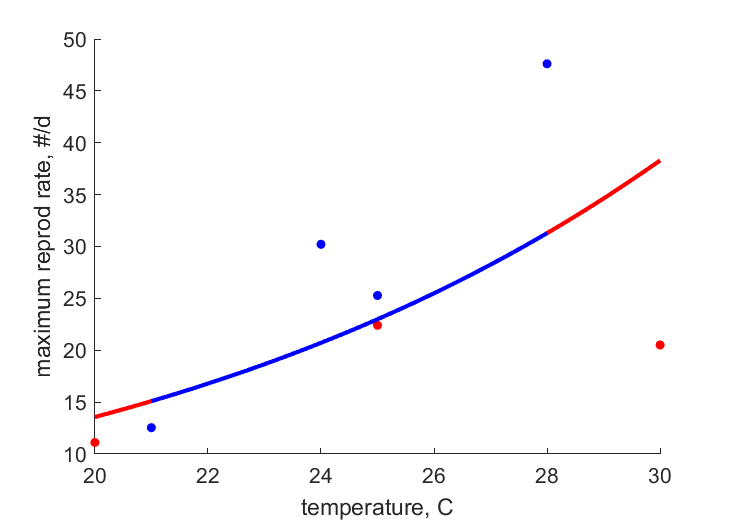  | temperature | maximum reprod rate | (0.3149) | XiaWerf1999 |
| TRi1 |   | temperature | maximum reprod rate | (0.3214) | Sund1966, FaroZhu2020, OmkaSriv2003, SingSing1993 |
| Ttbj | 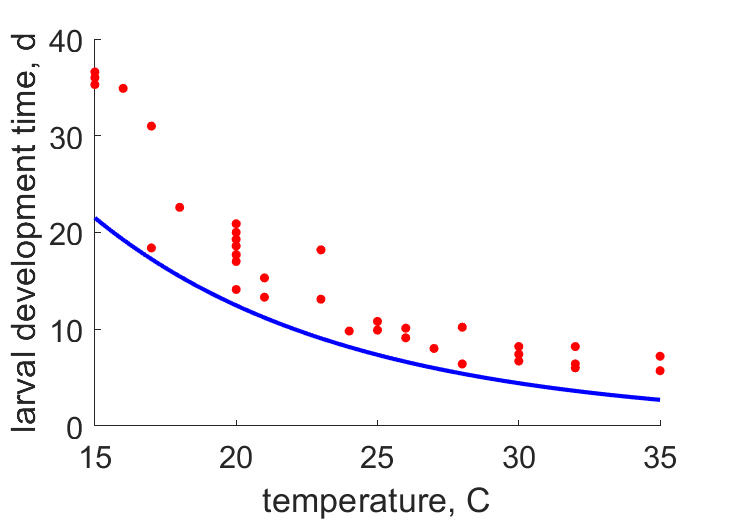 | temperature | larval development time | (0.3501) | TrilFrei1996 |
| Ttei | 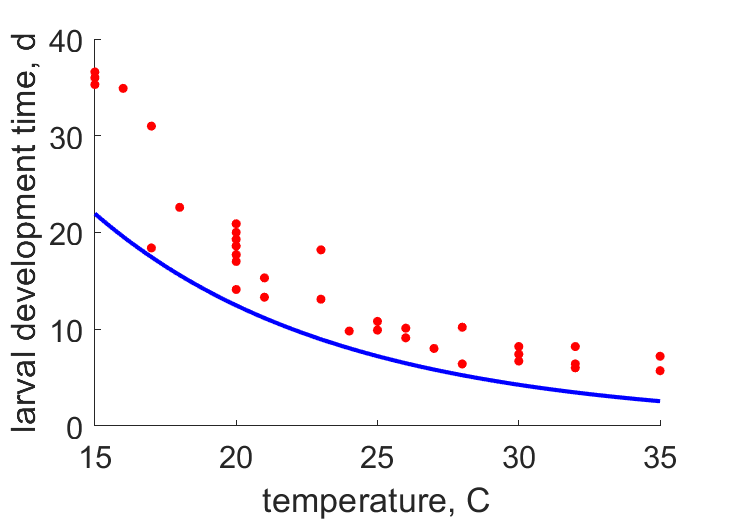 | temperature | mean imago life span | (0.4039) | XiaWerf1999 |
| Ttep | 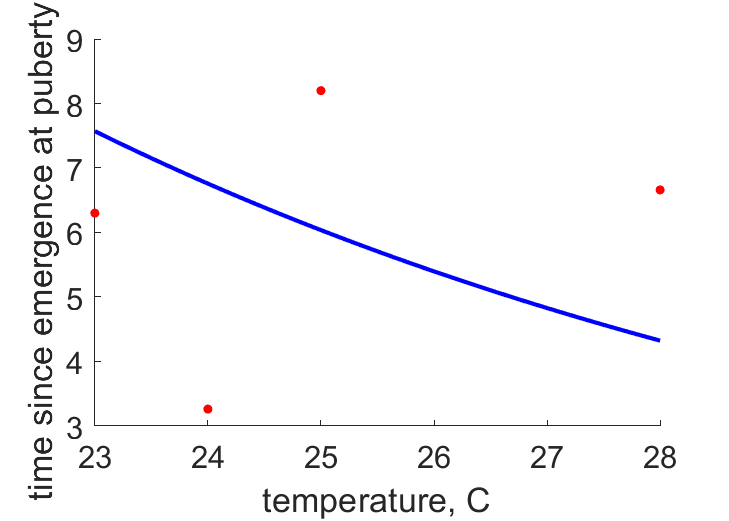 | temperature | time since emergence at puberty | (0.3796) | ObryOrr1990, FaroZhu2020, OmkaSriv2003, SingSing1993 |
Pseudo-data at Tref = 20°C
| Data | Generalised animal | Coccinella septempunctata | Unit | Description |
|---|---|---|---|---|
| v | 0.02 | 0.01 | cm/d | energy conductance |
| p_M | 18 | 3140 | J/d.cm^3 | vol-spec som maint |
| k_J | 0.002 | 0.002 | 1/d | maturity maint rate coefficient |
| k | 0.3 | 0.002817 | - | maintenance ratio |
| kap | 0.8 | 0.7656 | - | allocation fraction to soma |
| kap_G | 0.8 | 0.804 | - | growth efficiency |
| kap_R | 0.95 | 0.95 | - | reproduction efficiency |
Discussion
- For now, this entry focuses only on females
- It is assumed that the start of energetic investment in the reproduction takes place during the imago stage (synovigeny) because (a) imagos still feed on live prey, and (b) the wet weight of total reproductive output exceeds the adult female wet weight by a lot (making reproductive investment only during the larval phase implausible)
- mod_1: Pupation is triggered by reserve density at emergence equals reserve density at pupation
- Whenever studies reported the pre-pupa duration, here it was added to the pupa phase due to functional similarity (neither feeding nor growth take place)
- Not all developmental studies reported the pre-pupa duration, meaning that it was either included in the larval or the pupal duration; however since the pre-pupa phase was always very short, the resulting uncertainty is considered tolerable
- mod_1: the kappa-rule applies to all stages
Facts
- Development of ovaries takes place after emergence in the female imago (Ref: PhooObry1995)
- Imagos continue feeding on aphids (Ref: JalaReit2019)
Acknowledgment
- The creation of the original entry was financially supported by Bayer AG
Bibliography